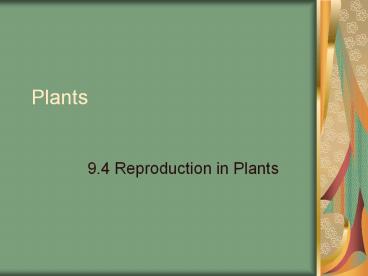Plants - PowerPoint PPT Presentation
1 / 18
Title: Plants
1
Plants
- 9.4 Reproduction in Plants
2
Flowering and Gene Expression
- Flowering involves a change in gene expression in
the shoot apex. - Vegetative structures roots, stems, and leaves
- When a seed germinates, the young plant is in the
VEGETATIVE PHASE. - Can last for weeks, months, years
3
Flowering and Gene Expression
- Flowering involves a change in gene expression in
the shoot apex. - The change from vegetative to REPRODUCTIVE PHASE
is marked by the production of the parts of
flowers instead of leaves by the shoot apical
meristems. - Flowers allow for sexual reproduction.
- What is sexual reproduction?
- Why is it beneficial? What are its challenges?
4
Flowering and Gene Expression
- Flowering involves a change in gene expression in
the shoot apex. - What triggers the change from vegetative to
reproductive phase? - Temperature can play a role
- Day length
- More precisely it is the length of dark period
- Some plants are short-day (ie long-night) plants
Poinsettia - Others are long-day (ie short-night) plants Red
clover - Why does the length of night matter?
5
Flowering and Gene Expression
- The switch to flowering is in response to the
length of light and dark periods in many plants. - Light plays a role in the inhibition or
activation of genes that control flowering. - Experiments have shown that plants measure the
length of dark periods. - A pigment in leaves of plants is used to measure
the dark - Called phytochrome
- Switches between two forms PR and PFR
- PFR is the active form
- Receptor proteins in the cytoplasm are able to
bind PFR not PR
6
Flowering and Gene Expression
- How does the plant use phytochrome to measure the
length of dark? - When PR absorbs red light it is converted to PFR
- When PFR absorbs far-red light it is converted to
PR - In normal sunlight, the red light is more
plentiful, so PR is rapidly converted to PFR - However, PR is more stable, so in the dark the
PFR slowly converts back to PR
7
Flowering and Gene Expression
- In long-day plants, large amounts of the PFR
remain after the short night. - The binding of PFR to the receptor promotes the
transcription of a flowering time gene (FT). - The FT mRNA is transported in the phloem to the
shoot apical meristem - In the meristem, it is translated into FT
protein. - The FT protein then binds to a transcription
factor. - This binding activates other genes necessary for
flowering to occur.
8
Flowering and Gene Expression
- In short-day plants, the binding of PFR to the
receptor inhibits the transcription of the
flowering time gene. - At the end of long nights, very little PFR
remains. - The inhibition fails.
- The transcription and translation of genes needed
for flowering are signalled. - QUESTION
- Contrast the control of flowering in short and
long day plants.
9
Mutualism between flowers and pollinators
- Most flowering plants use mutualistic
relationships with pollinators in sexual
reproduction. - Sexual reproduction requires the transfer of
pollen. - QUESTION
- List methods of pollen transfer.
- State advantages and disadvantages of each.
10
Mutualism between flowers and pollinators
- Animals that transfer pollen are known as
pollinators. - Examples birds, insects, rodents
- Mutualism a close association between 2
organisms where both organisms benefit. - Question
- Explain how both plants and animals benefit from
this relationship.
11
Parts of a flower
- Draw your version of the structure of an animal
pollinated flower - Label and annotate
- Discuss how this structure aligns with its
function. - See pg 431
12
Pollination, fertilization, and seed dispersal
- Success in plant reproduction depends on
pollination, fertilization, and seed dispersal. - Pollination is the process by which pollen is
transferred from the anther (male part) to the
stigma (female part) of the plant.
13
Pollination, fertilization, and seed dispersal
- when pollen has landed on the stigma of a
suitable flower of the same species, a chain of
events happens that ends in the making of seeds - A pollen grain grows a tiny tube, all the way
down the style to the ovary. - This pollen tube carries a male gamete to meet
the ovary in an ovule.
14
Pollination, fertilization, and seed dispersal
- Fertilization the process during which two
gametes join and their chromosomes combine, so
that the fertilised cell contains a normal
complement of chromosomes.
15
Pollination, fertilization, and seed dispersal
- The fertilized ovule goes on to form a seed,
- contains a food store and an embryo that will
later grow into a new plant. - The ovary develops into a fruit to protect the
seed.
16
Pollination, fertilization, and seed dispersal
- Seeds can not move themselves, yet often travel
long distances from the parent plant. - Why?
- How?
17
Pollination, fertilization, and seed dispersal
- Seed dispersal
- Reduces the competition between offspring and
parent. - Helps spread the species.
18
The structure of seeds
- Draw the internal structure of a seed
- Label and annotate
- See page 434































